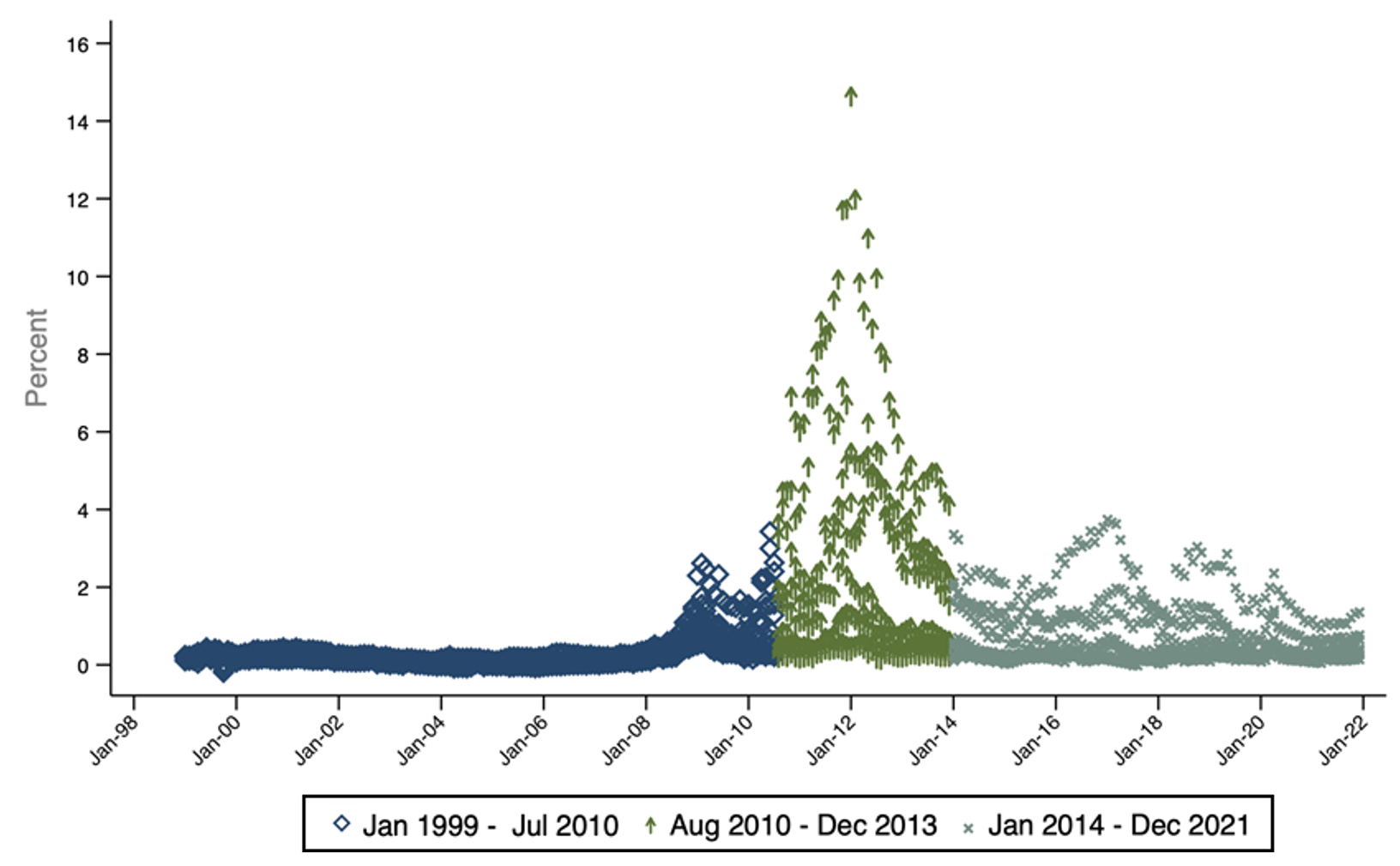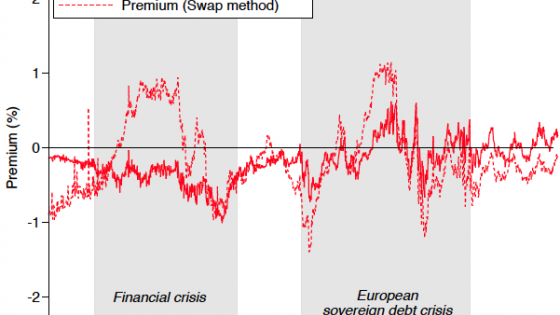The evolution of euro area sovereign bond spreads has gone through multiple phases since the 1990s, and has been the subject of significant research interest. In the early years of the monetary union, when these bond spreads were converging, several authors explained this, mostly through macroeconomic factors. The importance of financial linkages and market sentiment factors swelled the closer studies near the global crisis. When this crisis evolved in Europe into the sovereign debt crisis in 2009 and Economic and Monetary Union (EMU) convertibility risk rose (e.g. Eijffinger et al. 2018), a rupture between core and peripheral euro area countries became visible and an important topic for studies. From this vast field, Gómez-Puig et al. (2014) tested the importance of macro fundamental factors for these spreads with the most comprehensive set of variables for 1999 to 2012. At the same time, another strand of the literature determines euro area sovereign bond spreads through risk factors that are commonly accepted to drive bond returns. Credit risk and liquidity risk are the main ones, occasionally complemented with international market risk or volatility risk and exchange rate risk. Both strands document early evidence that the ECB’s early policy response to the sovereign debt crisis tightened government bond spreads. Following Draghi’s "whatever it takes" statement in 2012, the impact of the ECB’s monetary policy on the spreads quickly grew into a field of its own. Altavilla et al. (2019) is one of many studies that document a noticeable impact from the ECB’s announcement of unconventional monetary policies on euro area spreads. Afonso et al. (2018) control for time-varying heterogeneity in a multidimensional factor structure and still detect a sizeable effect from the ECB’s asset purchase programs (see also Samarina and Van der Cruijsen 2021).
In our recent CEPR Discussion Paper (Eijffinger and Pieterse-Bloem 2022) we document the research journey that we have taken to empirically establish the fundamental drivers of the spreads in ten-year government bond yields for ten euro area member states relative to the Germany ten-year Bund, and additionally, what the influence of the ECB’s policies have been on those spreads. We determine the drivers of euro area government bond spreads in a multidimensional factor structure through a time-series regression model that enables factor-specific, time-specific, and region-specific heterogeneities and a general-to-specific empirical approach, similar to Gómez-Puig et al. (2014). Our general unrestricted model encompasses the relevant category of factors for a Macro Fundamental-based (MF) model and a Market Risk-based (MR) model. Factors are described by a set of variables. The general-to-specific approach to identify the best specification for the model uses all in a generally unrestricted linear fixed-effects regression, and stepwise excludes variables for lack of statistical and economic significance.
We aim to identify a general model that can describe the spreads over the past 25 years. We start with the Macro Fundamental-based model with variables for macroeconomic factors, financial linkages, and market sentiment factors, firstly for the period 1999-2012. However, despite trying with different variable combinations and permutations, we are not able to identify a specification for the MF model for this period of a satisfactory quality. Specifications are unstable and a structurally significant constant term indicates an omitted variable problem. When we extend our best specification of the MF-model to 2013-2021, it performs worse. We do however learn that market sentiment factors perform better, that panel data for the euro area countries perform better than comparable variables at regional or global level, and that Greece is such an outlier that should be omitted.
In the course of our empirical journey, we notice that spreads behave differently in different periods. We use the methodology for panel data in Ditzen et al. (2021) and Karavias et al. (2021) for the Bai-Perron (1998) sequential test to determine unknown breakpoints. Our reformulation of this sequential test to capture significant alterations in the distribution of spreads over time, has, to the best of our knowledge, not previously been applied to euro area sovereign spreads. We find two major breakpoints, in August 2010 and January 2014 which define the three regimes in the figure below, copied from Eijffinger and Pieterse-Bloem (2022). In the first regime, spreads mostly converge and widen somewhat when the global crisis initially occurs in 2008. Spreads only react severely when Greece announces a larger-than-expected budget deficit in 2009, but not severely enough to break the trend in their joint distribution. This only occurs in August 2010 when the euro area falls more deeply into its debt crisis. In this second regime, the euro area’s convertibility risk (as defined by Eijffinger et al. 2018) spikes in early Summer 2012. Draghi’s ‘whatever-it-takes’ moment occurs at the peak of the spreads which subsequently decline but, distribution-wise, settle into a new regime only in January 2014. In this last regime spreads decline but do not regain the lows of the first regime.
Figure 1 Regimes in euro area sovereign bond spreads, defined by sequential breakpoint analysis
The findings with the fitting of the Macro Fundamental model motivate us to switch the Market Risk-based model, focusing on the post-2013 period. We use credit default swap (CDS) par spreads for single-name euro area sovereigns to describe credit risk, and the bid-ask spread in their bonds to describe liquidity risk. We extend this baseline specification with various variables to describe interest rate risk, volatility risk, exchange rate risk, and EMU (break-up) risk. Again, following a general-to-specific approach, we find that the difference between the Federal Reserve’s and the ECB’s target rate, stock returns in the individual euro area equity market amplified by their volatility, and outstanding balances of euro area countries in Target2 relative to their GDP add the most to the explanatory power of model. We further add stock variables for the ECB’s main refinancing operations (MRO), long term refinancing operations (LTRO), and asset purchases under its various quantitative easing programs (QE), defined as monthly growth rates. We find that the LTRO has very small explanatory power, but that QE has overwhelming explanatory power on spreads and that this specification is also able to describe the period before 2012/2013 well.
Overseeing the total of our empirical results, we repeat the conclusions made in our paper (Eijffinger and Pieterse-Bloem 2022), namely, that the determinants of euro area sovereign bond spreads tell the tale of different regimes which are predominantly characterised by the ECB’s transition from conventional to increasingly unconventional monetary policy and that this transition coincides with the change from the first two presidencies of Duisenberg and Trichet to those of Draghi and Lagarde. We infer from this that both sets of presidencies have interpreted and implemented the mandate of the central bank in a very different way. While under Duisenberg and Trichet the ECB only acted in the euro area money market, under Draghi and Lagarde the central bank has increasingly acted in the capital market. The growing detachment of sovereign bond spreads with macro fundamentals, detected through our fitting of the Macro Fundamental-based factor model and significantly better ability of the Market Risk-based factor model to explain the drivers in euro area sovereign bonds, with ample explanatory power of the ECB’s quantitative easing purchases, all speak to this tale.
References
Afonso, A, M G Arghyrou, M D Gadea and A Kontonikas (2018), “‘Whatever it takes’ to resolve the European sovereign debt crisis? Bond pricing regime switches and monetary policy effects”, Journal of International Money and Finance 86: 1-30.
Altavilla, C, L Brugnolini, R S Gürkaynak, R Motto and G Ragusa (2019), “Measuring euro area monetary policy”, Journal of Monetary Economics 108: 162-179.
Bai, J and P Perron (1998), “Estimating and testing linear models with multiple structural changes”, Econometrica 66: 47–78.
Ditzen, J, Y Karavias and J Westerlund (2021), “Testing and Estimating Structural Breaks in Time Series and Panel Data in Stata”, arXiv:2110.14550v2.
Eijffinger, S C W, M L Kobielarz and B R Uras (2018), “Sovereign default, exit and contagion in a monetary union”, Journal of International Economics 113: 1-19.
Eijffinger, S C W and M Pieterse-Bloem (2022), “Eurozone Government Bond Spreads: A Tale of Different ECB Policy Regimes”, CEPR Discussion Paper No. 17533.
Gómez-Puig, M, S Sosvilla-Rivero and M del Carmen Ramos-Herrera (2014), “An update on EMU sovereign yield spread drivers in times of crisis: A panel data analysis”, North American Journal of Economics and Finance 30: 133–153.
Karavias, Y, J Westerlund and P Narayan (2021), “Structural Breaks in Interactive Effects Panels and the Stock Market Reaction to COVID-19”, Journal of Business & Economic Statistics, online access.
Samarina, A and C Van der Cruijsen (2021), “Trust in the ECB during the pandemic”, VoxEU.org, 3 October.




